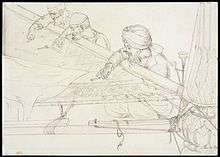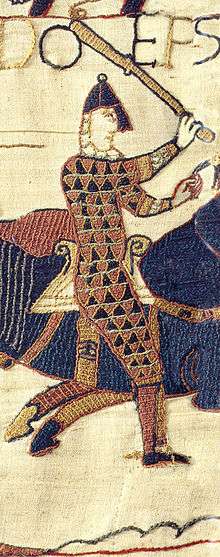Zardozi

Zardozi or Zar-douzi (Persian: زَردوزی, Arabic: خرير الماء, Hindi: ज़रदोज़ी, Urdu: زَردوزی, Azerbaijani: Zərdozi, work is a type of embroidery in Iran, Azerbaijan, Iraq,[1] Kuwait, Turkey, Central Asia, India, Pakistan and Bangladesh. Zardozi comes from two Persian words: zar, meaning 'gold', and dozi, meaning 'work'. Zardozi embroidery is a type of metal embroidery. It was also used to adorn walls of the royal tents, scabbards, wall hangings and the paraphernalia of regal elephants and horses. Zardozi embroidery work involves making elaborate designs using gold and silver threads along with studded pearls and precious stones.
Initially, the embroidery was done with pure silver wires and real gold leaves. However, today, craftsmen make use of a combination of copper wire, with a golden or silver polish, and silk thread.
Indian subcontinent

Gold embroidery has been in existence in India from ancient time. It prospered, but later a loss of royal patronage and industrialization led to its decline. Today, it is popular in the Indian cities of Lucknow, Farrukhabad, Chennai and Bhopal.[2] In 2013 the Geographical Indication Registry (GIR) accorded the Geographical Indication (GI) registration to the Lucknow Zardozi – the world-renowned textile embroidery from Lucknow. The Zardozi products manufactured in areas in Lucknow and six surrounding districts of Barabanki, Unnao, Sitapur, Rae Bareli, Hardoi and Amethi became a brand and can carry a registered logo to confirm their authenticity.One of the famous market in the field of manufacturing embroidery is farrukhabad . Rehmani embroidery work is one of the most famous embroidery manufacturing firm in the city of farrukhabad [3]
Iran
Zardozi is an important handicraft in Persian culture. It is known around the country by names such as zar-douzi (Persian: زردوزی), kam-douzi (Persian: کمدوزی), gol-douzi (Persian: گلدوزی) and kaman-douzi (Persian: کماندوزی). Nowadays it is more popular in Hormozgan, especially in Bandar-e Lenge, Bandar-e Abbas, and Minab.[4]
Persian zardozi is of three kinds:
- Some people completely sew the basic fabric with Bakhie (Persian: بخیه) in order to produce novel patterns and colors, such as the Baloch's Souzan-douzi (Persian: سوزندوزی), Rasht's Qollab-douzi (Persian: قلابدوزی) and Kerman's Pate-douzi (Persian: پَتهدوزی).
- Some sew with less density of work on the original fabric. They cross the strings throughout the woof of the fabric and sew them to each other to form a colorfully patterned lattice, such as sekke-douzi (Persian: سکّهدوزی) or qollab-douzi (Persian: قلابدوزی) in Isfahan.
- A third way is to sew a variety of patterns on the original fabric with gold and silver strings, such as Dah-Yek-Douzi (Persian: دهيکدوزی), Naqade-douzi (Persian: نقدهدوزی), Tafte-douzi (Persian: تافتهدوزی), Kous-douzi (Persian: خوسدوزی) Zari-douzi (Persian: زردوزی) or Golabatoun-douzi (Persian: گلابتوندوزی).[4]
References
- ↑ "Zardozi" p 13
- ↑ Zardozi in India- Zardozi Embroidery, Zardozi Work, Zardosi Embroidery in India, Indian Zari Embroidery
- ↑ "Lucknow zardozi gets GI registration". The Business Standard. April 24, 2013. Retrieved 10 July 2013.
- 1 2 گلابتوندوزی، آفتابنيوز، 5 بهمن 1387
External links
| Wikimedia Commons has media related to Zardozi. |


